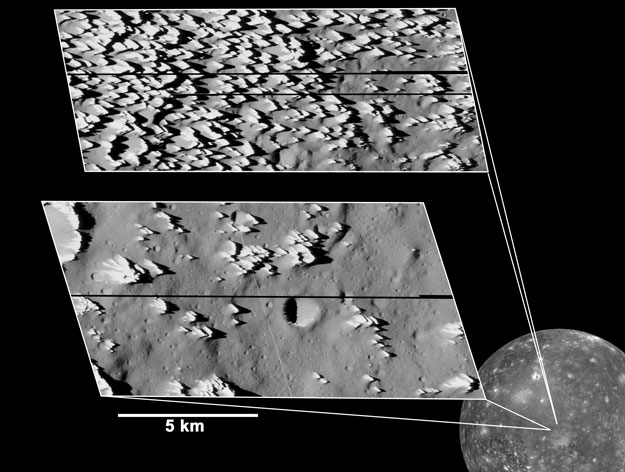Explanation: Why does Jupiter's moon Callisto have unusual jagged hills? This mystery came to light after the robot spacecraft Galileo, in orbit around Jupiter since 1995, swooped past the dark moon in May. The resulting pictures were the highest resolution yet obtained for a Jovian moon: objects as small as 3 meters across are discernable. The strange landscapes pictured above show areas rich in bright sharp mounds about 100 meters tall. A likely formation hypothesis holds that these hills are the result of ejecta thrown billions of years ago during a violent impact. The lower inset region apparently has undergone an epoch of relatively high ice-erosion, where dark rock has filled in some of the inter-hill regions. NASA has recently cleared Galileo to continue swooping Jupiter's moons until 2003, when it will end its journey with a spectacular dive into Jupiter's atmosphere.
1999 2000 2001 2002 2003 2004 2005 2006 2007 2008 2009 2010 2011 2012 2013 2014 2015 2016 2017 2018 2019 2020 2021 2022 2023 2024 2025 |
Yanvar' Fevral' Mart Aprel' Mai Iyun' Iyul' Avgust Sentyabr' Oktyabr' Noyabr' Dekabr' |
NASA Web Site Statements, Warnings, and Disclaimers
NASA Official: Jay Norris. Specific rights apply.
A service of: LHEA at NASA / GSFC
& Michigan Tech. U.
|
Publikacii s klyuchevymi slovami:
Jupiter - Callisto - Kallisto - Yupiter
Publikacii so slovami: Jupiter - Callisto - Kallisto - Yupiter | |
Sm. takzhe:
Vse publikacii na tu zhe temu >> | |
